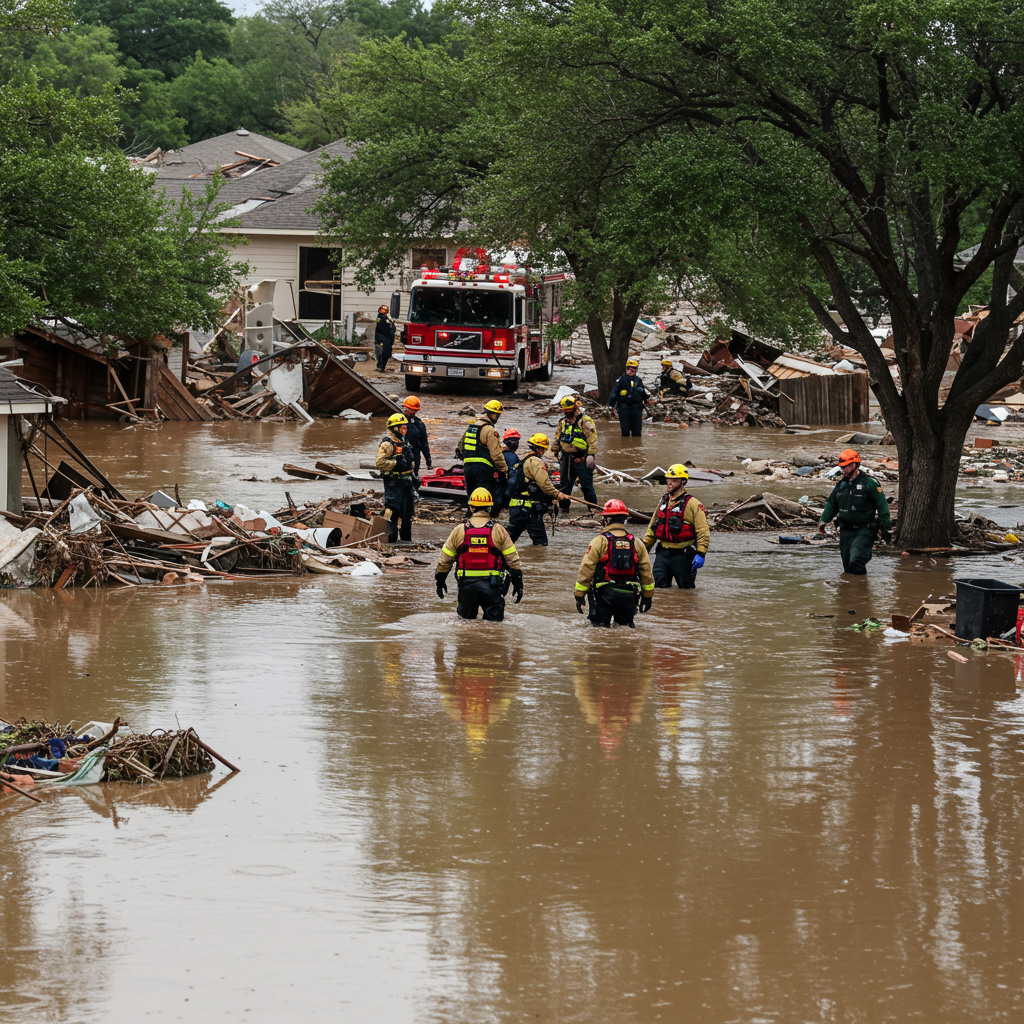Devastating flash floods overwhelmed communities across Central Texas following the July 4th holiday, dramatically shifting conditions from drought to disaster in mere hours. As the waters began to recede in some areas, the true human cost of the unprecedented rainfall emerged, revealing a heartbreaking landscape of loss, displacement, and urgent recovery efforts. Search and rescue teams worked tirelessly through the week, confirming a rising death toll while scores remained missing across the impacted counties.
The suddenness of the deluge caught many residents unprepared. While Central Texas is known as “flash flood alley” due to its rugged terrain and propensity for rapid water accumulation, the scale and speed of these floods were extreme. Just days before the holiday weekend, the region was experiencing dry conditions, with June marked as Austin’s driest in over a decade. Then, relentless rain poured down, causing rivers like the Guadalupe to surge dozens of feet in less than an hour, turning tranquil waterways into torrents that swept away homes and lives.
Widespread Impact Across Central Texas
The severe flooding impacted multiple counties, leading to significant casualties and widespread damage. As of Tuesday afternoon, the statewide death toll had tragically climbed to 109. The vast majority of these confirmed fatalities occurred in Kerr county, which bore the brunt of the disaster. Governor Greg Abbott reported a staggering 161 people were still missing in Kerr County alone as of Tuesday, a grim indicator of the challenges facing search teams.
Travis County, home to Austin, also saw significant loss, with seven deaths confirmed and 10 individuals still reported missing. The Big Sandy Creek area in northwestern Travis County experienced extreme devastation, leaving residents reeling from the suddenness and severity of the impact. Williamson and Burnet counties also reported fatalities and missing persons, adding to the regional crisis.
Heartbreaking Stories of Loss
Among the many victims confirmed in the wake of the floods are individuals whose lives were tragically cut short by the rising waters. One heartbreaking loss included a 20-month-old Austin boy, identified as Clay Parisher. Young Clay died in the Kerr County flash flood while celebrating the July 4th holiday with his family at their home near Ingram. The family’s house was tragically engulfed by the rapidly rising Guadalupe River. His uncle confirmed the devastating news, adding a deeply personal face to the immense tragedy unfolding in the region.
In Williamson County, authorities identified 64-year-old Sherry Merlene Richardson of Liberty Hill as one victim. Her daughter recounted the terrifying moments when Sherry called 911 from her home as water began rising up her stairs. Contact was lost approximately 15 minutes into the call. Tragically, Sherry died along with her beloved dog when her home was swept into a creek. Another Williamson County victim was identified earlier as 22-year-old Kaitlyn Swallow.
The floods also claimed young lives closer to Austin. Braxton Jarmon, a rising sophomore at Glenn High School in the Leander area, was confirmed dead. Braxton was a cherished member of the school community, located near the hard-hit Big Sandy Creek area. Reports indicated his sister and stepmother were among those still missing. In Burnet County, among the five confirmed fatalities was 22-year-old Preston Prince. Search efforts continued for Marble Falls Volunteer Fire Department Chief Michael Phillips, who went missing after being swept away by floodwaters while responding to an emergency call.
Search and Rescue Efforts Continue
Hundreds of first responders, including local teams, state agencies, and national assets, were engaged in extensive search and rescue operations across the affected counties. K9 units, air support, and watercraft were crucial tools in navigating the challenging debris-filled landscapes. As of Sunday, reports indicated over 650 people had been rescued or evacuated statewide, highlighting the immediate danger faced by those near the rising rivers and creeks.
A major focus of the search was centered on Kerr County, particularly around the area of Camp Mystic, a Christian girls’ camp on the Guadalupe River. The camp was reportedly devastated, with structures washed away and debris scattered. While many bodies were recovered in the county, five young campers and a counselor from Camp Mystic were still reported missing as of Tuesday, adding urgency to the ongoing efforts. Officials pledged to continue searching until everyone reported missing was accounted for.
Widespread Damage and Infrastructure Challenges
The sheer force of the floodwaters left a trail of destruction impacting homes, businesses, and critical infrastructure. In Williamson County alone, 38 properties were initially classified as destroyed or sustaining major damage. The floods also caused significant disruption to transportation, with eleven roads remaining closed in Williamson County as of Tuesday. Seven were still impassable due to high water, while four sustained pavement damage.
Similarly, Travis County reported multiple road closures, including some due to high water and others, like a section of Round Mountain Road, where bridges were damaged. Damage assessment teams, including those from external fire departments, began the daunting task of evaluating the full extent of the property and infrastructure loss. Residents in unincorporated areas were advised on how to separate debris for cleanup, emphasizing the massive undertaking required to clear affected properties.
Community Rallies for Support
In the face of such widespread devastation, communities across Central Texas quickly mobilized to support those affected. Nonprofits, businesses, and individual volunteers stepped up to provide aid. The Georgetown Project, a nonprofit supporting children and families, began seeking donations to fund essential needs like emergency hotel stays and gift cards for families displaced by flooding along the San Gabriel River. The organization reported already assisting dozens of adults and children with immediate needs like clothing and shelter.
Local businesses and other organizations, including churches and assistance groups, joined forces to provide support, offering everything from meals to clothing and cleaning supplies. Residents near the hardest-hit areas, like those near Big Sandy Creek in northwestern Travis County, described the outpouring of help, with volunteers arriving quickly with water, food, and necessities for cleanup efforts. The scene, initially one of shock and devastation, soon became one of neighbors helping neighbors and strangers lending a hand. Even the Faith Academy Marble Falls football team traded their practice gear for boots and gloves, helping clear mud and debris at a nearby trailer park devastated by the floods, exemplifying the powerful community spirit in times of crisis.
Official Response and Recovery Planning
State and county officials responded to the disaster with emergency declarations, aid coordination, and early planning for long-term recovery. Governor Greg Abbott issued disaster declarations for affected counties, and federal assistance was also made available. Officials like Travis County Judge Andy Brown expressed deep condolences for the lives lost and acknowledged the challenges in the immediate aftermath.
Concerns were raised about emergency notifications, with Travis County officials stating they plan a thorough analysis of communication strategies once immediate response needs subside. Looking ahead, efforts began to address the rebuilding process. Travis County Commissioners voted to waive permit fees for residents unable to afford them for rebuilding flood-damaged homes. However, officials also stressed the importance of adhering to current building regulations, particularly in floodplains. Homes in these areas must be elevated, and those deemed to have sustained “substantial damage” according to FEMA regulations cannot be rebuilt in the floodplain at all, a measure intended to prevent future tragedies in areas increasingly prone to flooding due to changing weather patterns. State legislators, including Governor Abbott, pledged to prioritize disaster relief and preparedness in upcoming legislative sessions.
Resources for Affected Residents
For residents impacted by the Central Texas floods, numerous resources are available to provide assistance:
Reporting Damage: Document property damage and report it to the Texas Department of Emergency Management online to help coordinate resource allocation.
Debris Cleanup: In unincorporated areas, coordinate with county officials and separate waste into categories (large appliances, construction debris, vegetative debris) for curbside pickup.
Crisis Cleanup Hotline: Contact 512-201-4814 for volunteer assistance with cleanup and recovery.
American Red Cross: Offers temporary shelter, emotional support, and help locating missing loved ones. Call 1-800-733-2767.
Austin Disaster Relief Network: Provides support with cleaning homes, debris removal, and tarping. Call the Disaster Survivor Hotline at 512-806-0800 or dial 211.
The Georgetown Project: Seeking donations and providing assistance for families displaced by San Gabriel River flooding.
The path to recovery for Central Texas communities will be long and challenging, but the immediate outpouring of support from neighbors, volunteers, and organizations offers a beacon of hope amidst the devastation.
Frequently Asked Questions
How many people died in the Central Texas floods that occurred after July 4th?
As of Tuesday afternoon following the floods, the confirmed statewide death toll had reached 109. The vast majority of these fatalities, 94 deaths, were confirmed in Kerr County alone. Other counties including Travis, Williamson, and Burnet also reported confirmed flood-related deaths. The numbers evolved over several days as search efforts progressed.
Where were the most affected areas and how many people were reported missing?
Kerr County was the hardest-hit area in terms of confirmed deaths, with 94 fatalities. It also had the highest number of missing persons reported, with 161 individuals still unaccounted for as of Tuesday. Other heavily impacted areas included the Big Sandy Creek region in western Travis County, where 10 people were missing, and areas along the Guadalupe and San Gabriel rivers.
How can residents affected by the floods get assistance or report damage?
Residents needing assistance can contact the Crisis Cleanup hotline at 512-201-4814 for volunteer help with cleanup. The American Red Cross (1-800-733-2767) provides temporary shelter and support. The Austin Disaster Relief Network (512-806-0800 or 211) helps with home cleanup and debris removal. To report property damage and aid resource allocation, residents should document damage and submit it online to the Texas Department of Emergency Management.
The recovery process will require continued effort from residents, volunteers, and government agencies as Central Texas works to rebuild and heal from the devastating impact of these historic floods.
Word Count Check: 1211



